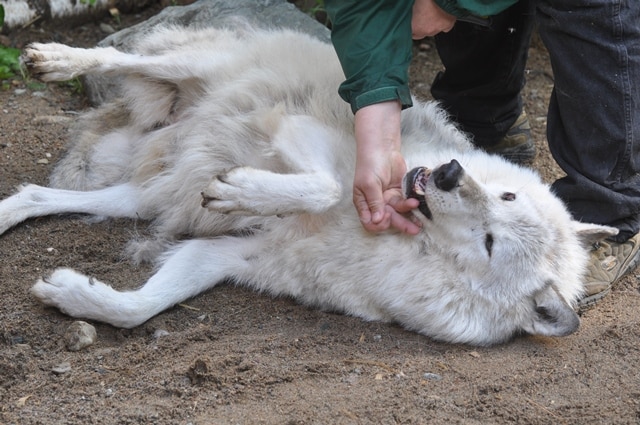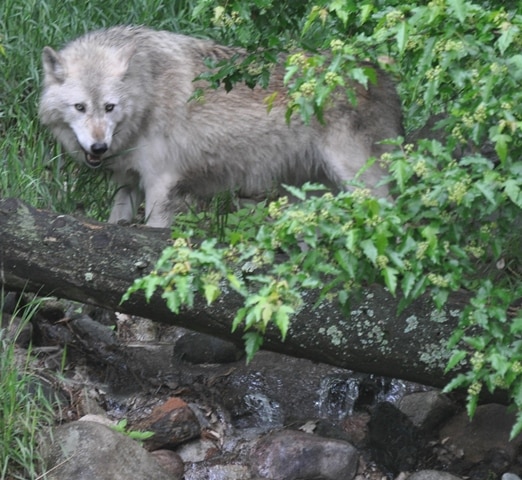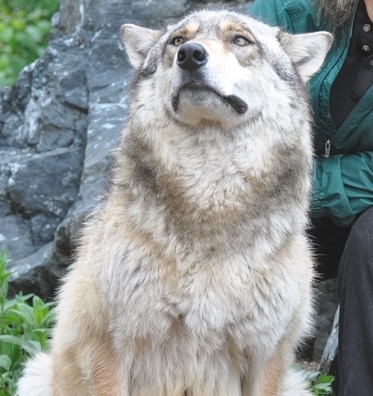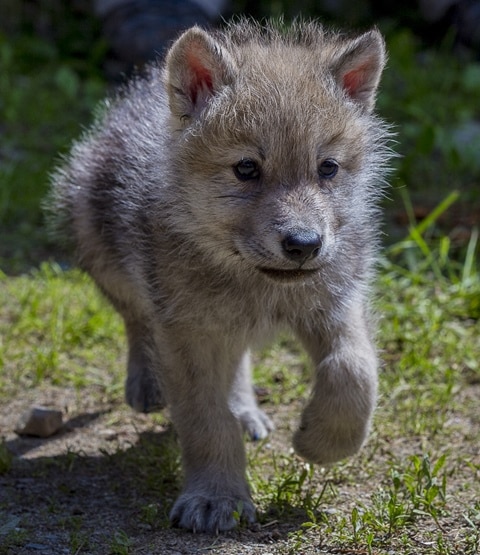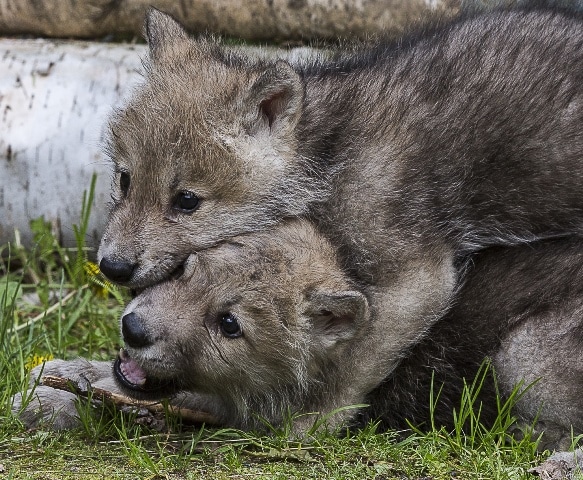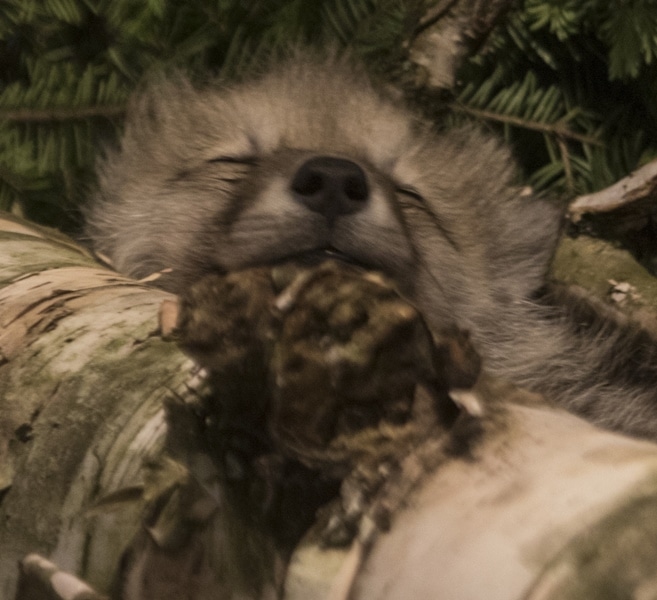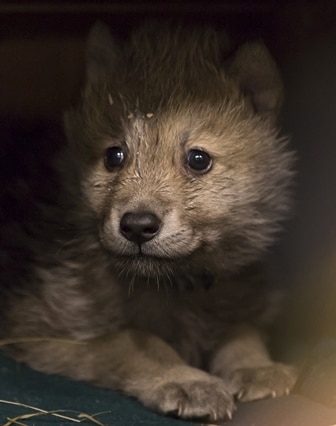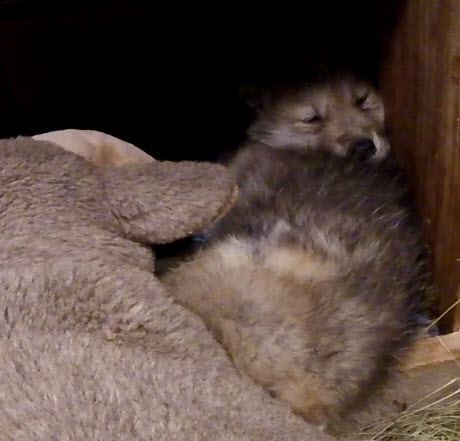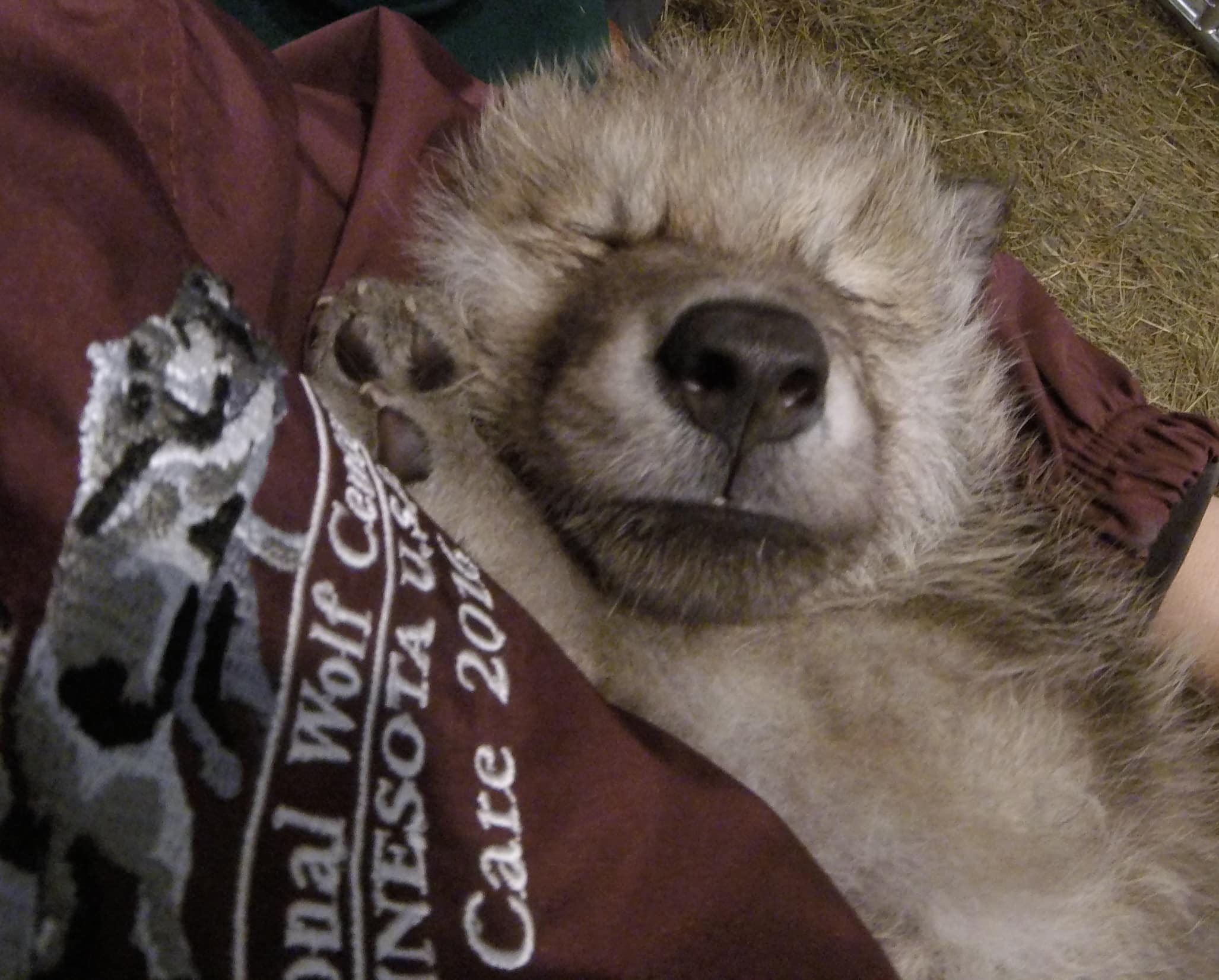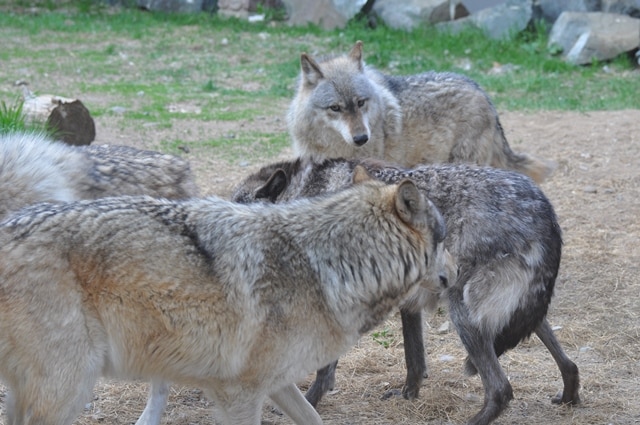Grizzer gets a full check of teeth, gums, eyes, ears, tick check and gets the benefit of wolf care grooming. He seems to enjoy it. We commented on a previous Youtube that Grizzer would be moved to the “East Side” retirement area while the pups use the “Pack Holding Area”, but I should have qualified that statement. The pups will not be ready for the “Pack Holding Area” until the end of June, so Grizzer has some time to be sharing the pup experience with a direct view of the pups as they leave the Wolf Care Center for programs. We will continue to give Grizzer much greater access to the pups than any other retired wolves have had. During the Working for Wolves program, we did some enclosure work so Grizzer can continue to use the “Back Habitat” in addition to the “East Side”retired enclosure once the pups move into the “Pack Holding Area”. As he travels from one space to the other, he will share a fence-line with the pups out of the watchful eye of the Exhibit Pack. Grizzer is the first Retired wolf to have face to face contact with the pups, and he does have contact. Every evening, when the hectic daytime exhibit quiets, he spends time whining and howling to the pups who are separated by a small vestibule and a large guillotine door.
Archives
We started the pump to fill the upper pond and Denali is quick to investigate the sound and movement of leaves as they flow down the rocks. Denali is extremely alert to anything that may be food related, but he is also stimulated by social greetings. After the Sunday afternoon pup program, the pups spent some time in a rare period of sunshine after several days of rain. Denali was immediately at the gate, whining to the pups. Axel approached halfway across the yard, but Grayback sought comfort from the wolf care staff. There is a noticeable difference between the two pups and it will take some time for them to get familiar with their future pack mates. Especially a wolf like Denali that looms so large over their heads.
The introduction of the pups to the Exhibit Pack created some interesting dynamics. Luna seems obsessed with the pups. We’re not sure if that’s a good thing, she has the same expression about a deer leg. Initially, she had been blocking the other wolves whenever the pups were near the fence, now Boltz joins her and the two of them block Aidan and Denali equally. Fortunately, Aidan is tolerant of it and we know he has a good history with pups, so it’s probably best that Luna and Boltz develop a strong bond. One other noticeable change for us is that Boltz is much more interactive and social in the last few days. This may coincide with the pups spending more time outdoors and possibly stimulating a bit of prolactin hormone for the Boltz or as he sheds his winter coat, maybe the back scratches are too good to resist. Regardless, this facial expression seems to indicate some positive interaction.
While we use the term socialized to identify the entire process of hand-raising pups, scientific literature describes this particular period of age development as the “Socialization Period categorized from 20 – 24 days to approximately 77 days”. During this period in the wild, pups begin appearing outside of the den, playing near the entrances, ears being to raise and are usually erect and hearing improves dramatically. As Axel’s photo shows, there is growth of the guard airs around the top of the head, nose and eyes. The disproportionate feet and large head will be the next notable features for the pups. Sleep is still a significant part of their life, but bouts of dominance increase when aroused. Axel and Grayback have been spending more time outdoors as the weather allows. The pups are weighed daily at 8 am and Axel gained .4 lbs in 24 hours.
While Grayback’s weight is progressing well, he is still a half a pound behind his littermate Axel. The pups are weighed each morning at 8 am, on June 5th, Grayback weighed 6.8 lbs. and today he is 7.1, a weight gain of .3 lbs. in 24 hours. Although weights can fluctuate at this age, the additional challenge for Grayback is that Axel tends to be a bit more mobile and has mastered some dominant moves. This will also fluctuate between pups, but at this point, it is one of the behavior indicators that may help people ID the pups.
Grayback is referred to as the less dominant pup in comparison to his brother, Axel. When he decides to play-wrestle, he will tend to go for the back leg of Axel, whereas Axel play-wrestles from the face. Grayback tends to sleep a little longer than Axel, and is often on the receiving end of Axel’s nips to wake up. Grayback has just mastered being able to climb up the hay bale. His favorite sleeping place is in the den box or beside the birch tree. When feeding, Grayback will often try to suckle the pup care staff’s fingers with gruel on it.
-Kim Goodbrandson, Pup Care Participant
Axel is a one month old Arctic wolf that has joined the IWC family. During the past week, his coat has lightened and his ears have become erect. He continues to interact with his brother, with some initial dominance characteristics-chin rests, standing over, and vocalizations. He alternates between being the initiator and on the receiving end. His walking, stalking, and pouncing skills are beginning to advance, and he is constantly climbing up on objects and attempting jumps to other platforms. He tends to use the den box more often for naps while his brother seeks solace behind some of the other objects in their area. He has a healthy appetite and has started lapping water from a bowl. He socializes well with the staff, and is intrigued by the howling of the Ambassador pack that takes place outside. Axel consistently chews on birch bark, trees, and hooves in their area.
-Chad Sell, Pup Care Participant
To anyone who follows our wolf care program, you may recognize two familiar objects in this photo (other than the pups). The first is the stuffed moose which was first purchased during the summer of 2000 for Shadow and Malik, the second is the wood den box built by Bob Mucha during the summer of 2008 for Aidan and Denali. We’ve been down this road before and know what pups like. At this age, they have limited ability to regulate their body temperatures so they seek each other (and the stuffed toys) out for warmth. Pups also like confined spaces, similar to dens of their birth. Providing these physical as well as psychological comforts helps the pups adapt to their new environment. Axel was nicknamed for Axel Heiberg Island, Nunavut, Canada’s second northernmost island, located in the High Arctic approximately 1,200 km from the North Pole. To learn more about arctic wolves, check out this link:
One of the main reasons why we socialize wolf pups is to build trust between staff and wolves in order to meet their basic physical and psychological needs in captivity. We believe in the method of positive conditioning young pups by creating a comfortable environment. In this photo, Grayback falls asleep in the arms of the wolf care staff after a feeding. The pups have been weaned from the bottle and are now lapping a mixture of meat and milk replacer, which will be their diet for a few more weeks. By the time they are 6 weeks old, we will gradually add larger amounts of meat to their diet. We conducted a “trail run” program in the auditorium last evening with Center staff and volunteers to give the pup a positive experience before we begin public programs on Memorial Day.
We coordinated the first face to face meeting (through the chainlink fence) with the 2016 pups and their future packmates, the Exhibit Pack. Luna dominated the scene, but Aidan, despite some trepidation (as displayed by his ears pricked and turned sideways ear posture) had some fence time and showed the same possessive behavior toward the new arrivals that he did in 2012 when Luna and Boltz were introduced. After the Pup Care team had a shift change, staff witnessed Aidan keeping watch at the fenceline and he initiated a howl to the pups. That’s the kind of pack leadership that will help the pup introduction be successful. The pups will have the next 2 months to develop a bond with the human handlers and the adult wolves through the fence before they join the pack in early August.

The International Wolf Center uses science-based education to teach and inspire the world about wolves, their ecology, and the wolf-human relationship.

